Hirschsprung’s disease is a congenital condition where nerve cells of the myenteric plexus are absent in the distal bowel and rectum. The myenteric plexus, also known as Auerbach’s plexus, forms the enteric nervous system. It is the brain of the gut.

This nerve plexus runs all the way along the bowel in the bowel wall, and is a complex web of neurones, ganglion cells, receptors, synapses and neurotransmitters. It is responsible for stimulating peristalsis of the large bowel. Without this stimulation the bowel looses it’s motility and stops being able to pass food along its length.
The key pathophysiology in Hirschsprung’s disease is the absence of parasympathetic ganglion cells. During fetal development these cells start higher in the GI tract and gradually migrate down to the distal colon and rectum. Hirschsprung’s occurs when the parasympathetic ganglion cells do not travel all the way down the colon, and a section of colon at the end is left without these parasympathetic ganglion cells.
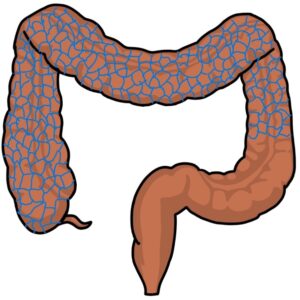
The length of colon without innervation varies between patients from a small area to the entire colon. When the entire colon is affected this is called total colonic aganglionosis. The aganglionic section of colon does not relax, causing it to becomes constricted. This leads to loss of movement of faeces and obstruction in the bowel. Proximal to the obstruction the bowel becomes distended and full.
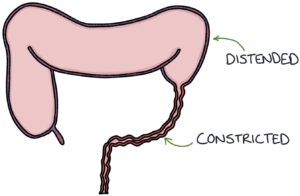
Genetics and Associations
There are a number of genes on various chromosomes that may have a modifying effect to increase the risk of Hirschsprung’s. A family history of Hirschsprung’s greatly increases the risk. Therefore where you are considering a diagnosis of Hirschsprung’s always take a careful family history.
Hirschsprung’s disease usually occurs in isolation, however it is associated with a number of other syndromes, including:
- Downs syndrome
- Neurofibromatosis
- Waardenburg syndrome (a genetic condition causing pale blue eyes, hearing loss and patches of white skin and hair)
- Multiple endocrine neoplasia type II
Presentation
The severity of the presentation and the age at diagnosis varies significantly depending on the individual and the extent of the bowel that is affected. It can present with acute intestinal obstruction shortly after birth or more gradually developing symptoms:
- Delay in passing meconium (more than 24 hours)
- Chronic constipation since birth
- Abdominal pain and distention
- Vomiting
- Poor weight gain and failure to thrive
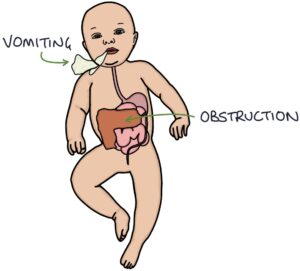
Hirschsprung-Associated Enterocolitis
Hirschsprung-associated enterocolitis (HAEC) is inflammation and obstruction of the intestine occurring in around 20% of neonates with Hirschsprung’s disease. It typically presents within 2-4 weeks of birth with fever, abdominal distention, diarrhoea (often with blood) and features of sepsis. It is life threatening and can lead to toxic megacolon and perforation of the bowel. It requires urgent antibiotics, fluid resuscitation and decompression of the obstructed bowel.
Management
Abdominal xray can be helpful in diagnosing intestinal obstruction and demonstrating features of HAEC.
Rectal biopsy is used to confirm the diagnosis. The bowel histology will demonstrates an absence of ganglionic cells.
Unwell children and those with enterocolitis will require initial fluid resuscitation and management of the intestinal obstruction. IV antibiotics are required in HAEC.
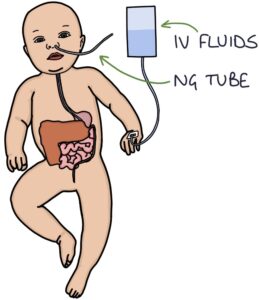
Definitive management is by surgical removal of the aganglionic section of bowel. Most patients will live a normal life after corrective surgery, although they can have long term disturbances in bowel function and may be left with some degree of incontinence.
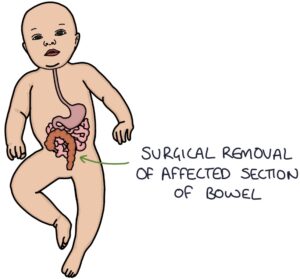
Last updated August 2019
